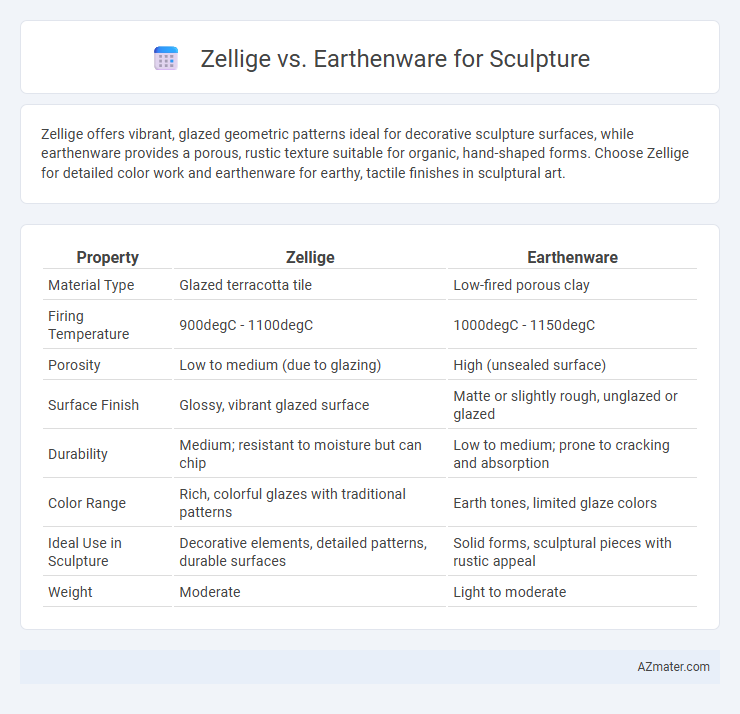Zellige offers vibrant, glazed geometric patterns ideal for decorative sculpture surfaces, while earthenware provides a porous, rustic texture suitable for organic, hand-shaped forms. Choose Zellige for detailed color work and earthenware for earthy, tactile finishes in sculptural art.
Table of Comparison
| Property | Zellige | Earthenware |
|---|---|---|
| Material Type | Glazed terracotta tile | Low-fired porous clay |
| Firing Temperature | 900degC - 1100degC | 1000degC - 1150degC |
| Porosity | Low to medium (due to glazing) | High (unsealed surface) |
| Surface Finish | Glossy, vibrant glazed surface | Matte or slightly rough, unglazed or glazed |
| Durability | Medium; resistant to moisture but can chip | Low to medium; prone to cracking and absorption |
| Color Range | Rich, colorful glazes with traditional patterns | Earth tones, limited glaze colors |
| Ideal Use in Sculpture | Decorative elements, detailed patterns, durable surfaces | Solid forms, sculptural pieces with rustic appeal |
| Weight | Moderate | Light to moderate |
Introduction: Zellige and Earthenware in Sculpture
Zellige, a traditional Moroccan mosaic tile made from glazed terracotta, offers vibrant, intricate patterns and a durable surface ideal for decorative sculptural elements. Earthenware, a porous clay-based ceramic fired at lower temperatures, provides a versatile medium favored for its workability and matte finish in sculptural applications. Both materials bring distinct aesthetic and textural qualities, with Zellige emphasizing ornamental mosaic artistry and earthenware highlighting earthy, tactile forms.
Historical Origins of Zellige and Earthenware
Zellige, originating in 10th-century Morocco, is a traditional form of glazed terracotta tile known for its intricate geometric patterns and vibrant colors, primarily used in architectural decoration. Earthenware, dating back to ancient civilizations such as Mesopotamia around 10,000 BCE, involves shaping clay and firing it at lower temperatures to create durable, porous pottery and sculptural forms. Both materials reflect distinctive cultural heritages and artistic techniques, with Zellige emphasizing ornamental mosaic craftsmanship and earthenware showcasing versatile clay modeling traditions.
Material Composition: Differences and Similarities
Zellige is crafted from natural clay and coated with a vibrant, glazed finish, renowned for its intricate geometric patterns and durability. Earthenware, composed of porous clay fired at lower temperatures, offers a more porous, matte surface ideal for sculptural detail and texture. Both materials share a clay-based origin but differ significantly in firing temperature and surface treatment, impacting their suitability and aesthetic for sculpture.
Techniques in Crafting Zellige vs. Earthenware
Zellige crafting involves meticulous hand-cutting of glazed terracotta tiles followed by precise assembly into intricate geometric patterns, demanding advanced skills in both tile shaping and mosaic placement. In contrast, earthenware sculpture techniques encompass hand-building, wheel-throwing, and slip casting, with a focus on shaping and firing unglazed or glazed clay to create solid three-dimensional forms. Both techniques require specialized knowledge of material properties and firing processes, but Zellige emphasizes surface pattern articulation while earthenware prioritizes volumetric sculpting.
Surface Texture and Visual Appeal
Zellige tiles offer a distinct glossy and irregular surface texture due to their handcrafted nature, enhancing sculptures with vibrant color variations and intricate patterns that catch the light beautifully. Earthenware, by contrast, features a more matte and porous texture, providing a rustic and organic visual appeal that emphasizes natural earthy tones and tactile depth. The choice between Zellige and earthenware significantly influences the sculpture's aesthetic impact, with Zellige favoring bold visual complexity and earthenware delivering subtle, textured warmth.
Durability and Longevity Comparison
Zellige tiles, made from fired clay with a glazed finish, offer superior durability and water resistance, making them ideal for sculptures exposed to moisture and outdoor elements. Earthenware, fired at lower temperatures and typically porous, is more susceptible to chipping, cracking, and weathering over time, limiting its longevity in harsh environments. For long-lasting sculptures requiring resilience, Zellige provides enhanced structural integrity and maintenance advantages over traditional earthenware.
Suitability for Indoor and Outdoor Sculptures
Zellige tiles, known for their glazed, water-resistant surface, offer excellent durability and vibrant color retention, making them highly suitable for both indoor and outdoor sculptures exposed to varying weather conditions. Earthenware, being porous and less resistant to moisture and temperature changes, is better suited for indoor sculptures where controlled environments prevent damage and deterioration. Choosing between Zellige and earthenware depends on the sculpture's location, with Zellige providing enhanced longevity outdoors and earthenware preferred for detailed indoor artistic expressions.
Artistic Flexibility and Design Potential
Zellige offers unparalleled artistic flexibility with its intricate geometric patterns and vibrant colors, making it ideal for detailed, mosaic-style sculptures. Earthenware provides a versatile medium for sculptors seeking organic textures and the ability to shape larger, more fluid forms with varied finishes. While Zellige excels in precise, decorative aesthetics, earthenware supports a broader range of tactile and expressive design potentials in sculpture.
Environmental Impact and Sustainability
Zellige tiles, made from natural clay and fired at high temperatures, offer remarkable durability and low environmental impact due to their long lifespan and minimal chemical treatments. Earthenware, while also clay-based, uses lower firing temperatures, resulting in higher porosity and shorter durability, which can lead to more frequent replacements and greater resource consumption. Sustainable sculpture practices favor Zellige for its resilience and reduced need for repairs or replacements, contributing to lower waste and energy use over time.
Cost Factors and Accessibility
Zellige tiles are handcrafted Moroccan ceramics known for their intricate geometric patterns, making them more costly due to labor-intensive production and limited availability outside specialized markets. Earthenware, composed of porous clay fired at lower temperatures, offers a more affordable and widely accessible option for sculptors seeking versatile material with easier sourcing. Budget-conscious artists often prefer earthenware for its lower cost and ready availability, while Zellige is favored for premium decorative sculptures despite higher expenses.

Infographic: Zellige vs Earthenware for Sculpture
 azmater.com
azmater.com